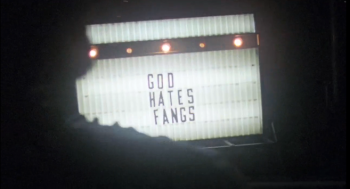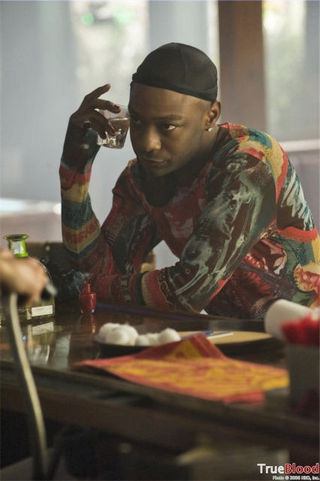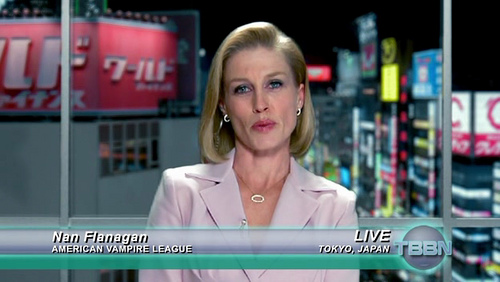Vampire Politics
Vampire Politics by: Lisa Nakamura / University of Illinois, Laurie Beth Clark / University of Wisconsin, and Michael Peterson / University of Wisconsin

“The TV title sequence is a branding endeavor and a legitimate art form. It is the sole, consistent, and iconic moment that carries through a show’s lifespan and beyond.” (Digital Kitchen)
The opening title sequence of True Blood (Allen Ball, HBO) produced by Digital Kitchen is a aesthetically stunning hoax. The production company that made the title sequence for True Blood, Digital Kitchen, has also done beautiful and complex credit sequences for Six Feet Under, Dexter, House, and Nip/Tuck, but True Blood’s is most completely a compelling and separate paratext. And unlike other title sequences whose innovative use of film technique and imaging to make it stand out from the film itself rather than blend unnoticeably with it, such as Se7en, its position at the beginning of a serial television show guarantees that it will viewed repeatedly. It tells a story and presents the viewer with a set of visual images that are uncomfortably sutured to the television program itself.
Edited to the catchy tune of Jace Everett’s “Bad Things”, this montage promiscuously merges what seems to be stock footage with more clearly original sequences, frequently using an art video (grainy, hand held) aesthetic to give documentary credibility to constructed materials. We believe that the clip of a man being carried away by police is civil rights era documentary footage and the child in the klan uniform seems also to be “real” while we assume that the “God Hates Fangs” sign is produced for the show. But the religious ecstasies and bar erotics and the many shots suggesting a seedy and inbred south are more ambiguous. And while we know the time-delay animal decompositions shots are “found” they are not contemporaneous to the work of the show.

The True Blood title sequence indulges in fascination with Southern Gothic cliche: alligators, catfish, ecstatic spirituality and sexuality, and an atmosphere of decay that bespeaks a perhaps in-bred mutation. The varied perspectives of Southern Gothic visual culture–from the imagery of Faulkner to many Tennessee Williams plays to the film Deliverance (1972) and even the photography of Ralph Eugene Meatyard (1925-1972) or William Eggleston (b. Memphis 1939) – all stare at the bodies of the south. These include enslaved deep black bodies, immobile obese pale bodies, deformed and violated bodies, repressed church lady bodies – and in keeping with this tradition the True Blood sequence stares even harder at the gyrating religious and sexual bodies that appear to emerge from this context.

Gothic visuality offers an idea of the “truth” of the South, revealing the violence, sexuality and faith that lie behind stereotypically polite Southern facades. True Blood‘s opening promises to show us a continuation of this fascination with diagnosing the South’s mutations, and the single shot of “God Hates Fangs” on a church sign (and its rhyming of the image of boys eating bloody barbecue/strawberries) intimates that it will offer Gothic with a new twist. But vampirism, while played for its erotic fascination, is not really integrated into a Southern Gothic milieu in True Blood. (Sookie arguably engages and dispatches the vestiges of white Southern Gothic depravity in the first episode, when she defeats the Rattrays, a trashy couple who are bleeding vampire Bill to death.) The violence, sexuality and religious ecstasy of the show itself are imported from other styles and genres.
Like the opening credits for Dexter (also produced by Digital Kitchen), the True Blood sequence promises to show us the ways in which everyday life is filled with the “same kind” of horror as vampire stories. Both explicitly and implicitly, the sequence suggests that the American south is full of the all kinds of real political, social, and natural violence: racism, homophobia, religious fundamentalism, and decomposing bodies. The credit sequence suggests that there “might as well be” vampires in the south and promises a show in which vampires as metaphor will be used to reveal a “truth” about ongoing historical violences. But this is not the show that follows the credit sequence. The south may be the back drop for Sookie Stackhouse and Bill Compton’s adventures, but it is not the world they engage. The rights of vampires, both political and domestic, are front and center, and the rights that the credits sequence suggest they stand in for are rarely represented, either narratively or in exposition.
Sookie Stackhouse, the program’s telepathic waitress protagonist, can hear what people are thinking; she has an interior radio permanently tuned to the South’s repressed. Sookie hears voices but these voice rarely document racist or sexist thinking, though classist assumptions abound. Either Sookie lives in a utopian future in which racism and homophobia are resolved or she is oblivious. Given the program’s preoccupation with the South as a site of struggle over various types of social integrations, race is the program’s repressed thing, the thing that if we tune closely enough into we, we can faintly hear in the background. And it is repressed for a reason—race has had its day as a concern, the credit sequences depict it as part of an antique and literally crumbling or melting past. Race struggles were never sexy in the way that vampires are in this program; vampires are self-fashioning sexy subjects in ways unavailable to and indeed impossible for people of color. Vampire rights are the world of the show and it is these rights, both political and domestic, that the show elaborates. That virulent (and excessively white) heterosexuality of vampires is an unlikely vehicle for the rights of gays, lesbians, and people of color and the relative absence of their (political) story lines does not address True Blood‘s metaphor problem.
Instead, race is displaced onto the credit sequences, which lead the viewer to expect extensive engagements with civil rights struggles, racialized violence, and affectively charged engagements between whites and blacks. Instead, this affect is entirely located within relations between vampires and humans. True Blood’s appeal has much to do with sex—surely the MPAA’s policies regarding obscenity and adhering to the “less than x number of thrusts” rule has been repeatedly violated in this program—but it’s sex with a difference. In an era in which Asian male protagonists rarely get any girl, and almost never a white one, and filmic miscegenation is still exceptional, despite our supposedly post-racial state, True Blood lets human-vampire sex stand in for the racial affect that is promised in the credits, but cannot occur in the program itself.
True Blood also shares with Dexter (and a remarkable number of other “hip” television shows including Big Love, The Riches, Weeds, and Nurse Jackie), a sense that justice requires vigilantism. A contemporary remake of an old west or “Dirty Harry” ethics, these shows ask us to empathize and root for figures who have created moral codes outside the law. The shows authorize their “vigilante” aesthetics by various means (Dexter Morgan’s childhood, Nancy Botwin’s widowhood, Jackie Peyton’s excessive work load, etc.). In True Blood, it is the implied identification of vampirism with other socially marginalized groups that authorizes Sookie, Bill and others to take things into their own fangs. But it is also a presumption about the general “fucked-up-ness” of the south that authorizes these behaviors, and this turns out the be the role of the credit sequence of the show, to alibi certain violences through the argument that the rest of world is so much worse.
One of the problems with “vigilante” hero stories is that they occlude, displace, or erase social movements. And if the series fails to deliver on the title’s implied promise of prurience, it also disdains the political tensions summoned by the sequence. True Blood occurs in a post-racist (if not post-racial) south, where racial mixing is treated with a pointed nonchalance. And if the church sign summons up the kind of homophobic bigotry displayed by notorious figures such as the Revered Jim Phelps, the show’s gay characters, most notably Lafayette, are sexually unconflicted and deal with homophobia and AIDS phobia with unalloyed triumphalism.

True Blood’s vampires have a fully developed television media campaign and even a spokeswoman, but she is far from the Cesar Chavez/Martin Luther King/Nelson Mandela styles of civil rights leader. Instead, her work is entirely banal, cast in the visual language of Fox News. The program’s frequent citations of her television appearances on mainstream television talk shows remind the viewer that rights-based movements, such as the gay rights, women’s rights, indigenous rights, and general civil rights group actions, require the right kind of mediation in order to succeed. The successful deployment of the language of civil rights, part of the South’s legacy, and their formation of a rights organization, depends greatly on their access to media and screen culture. “Visibility” is a requirement for rights, and television is the most penetrative and valuable medium in this regard — though the Zapatistas famously circumvented television’s cultural and industrial gatekeepers by leveraging the Internet to get out their message via Subcommandante Marcos in the nineties, their movement was the exception rather than the rule (see Manuel Castells’s The Power of Identity).
The vampire’s successful acquisition of prime time Fox-style talk television time is depicted as the only possible means of legitimation for vampires. Television is endowed with enormous power to create successful social movements; as vampire spokeswoman Nan Flanagan says to a rebellious Eric Northman, “I get to decide. Why? Because I’m on television.” This confirmation of traditional mainstream broadcast media as the way to “mainstream” into society contrasts greatly with the current media landscape as it stands now, where broadcast television and radio are in crisis, and YouTube means that everybody can “broadcast themselves.”

Within the logic of True Blood, however, the right to have rights must be earned through banal and hyper-conventional media campaigns. Bill’s on the ground efforts to integrate with the small town of Bon Temps are depicted as mostly sexual rights — nobody seems to contest his claim to own property, but they object greatly to his miscegenation with Sookie or any human female — and he is not involved in the “movement.” He is a model of civic virtue — as he states to his vampire teenager Jessica, “we recycle in this house!” — but ultimately is depoliticized as a social actor for vampire rights, indicating a neoliberal present that also views individuals as ultimately responsible for their own welfare, and also as responsible for broadcasting their claims for these rights in conventionally mediated ways. His desire to marry Sookie — the cliffhanger of season 2 — is fully domesticated as the fulfillment of an entirely individual desire rather than as part of a marriage-rights movement for vampires or other “others.”

True Blood is socially conservative, gesturing towards a radical politics (or any social movement based politics) that it cannot (or will not) deliver. Likewise, the form of the medium itself is conservative. Like its vampires, True Blood is a relic – it airs on television, not the Internet, and it is broadcast rather than streamed. Though HBO claims “it’s not television, it’s HBO,” we know better. Like the credit sequence’s time-delayed decayed foxes and possums, True Blood is a memento mori – to the Civil Rights South, to broadcast television, to civil rights organizing and “unsexy” rights-based movements. True Blood pursues vampire politics, which are all about sexy self fashioning. Were it not for the exquisite Godric’s self-immolation in season two, the program’s credo might be “survival of the sexiest.”
Image Credits:
1. HBO’s True Blood
2. Old man in rocking share from True Blood opening credits – Author’s screenshot
3. The “God Hates Fangs” sign from the opening sequence – Author’s screenshot
4. Lafayette
5. Nan Flanagan
6. Vampire Eric Northam
Please feel free to comment.
I stopped watching True Blood shortly after the show began, but I always loved its credits. And yet, for me, they are a problematic representation of the show’s politics, as the show rarely if ever engages in the broader integration of vampires and humans within society at large (you could argue the introduction of religious fundamentalism serves this purpose, but placing the show’s most dim-witted character at the center of it sort of killed any dramatic potential for me in my brief return to the show early in Season 2). The idea of using the vampires as a way to actually shed light on the experience of minorities in American culture felt like a premise that could have been taken much further, and yet Ball seems to be following the pulpy content of the source material as opposed to necessarily following a more interesting path.
For me, the credits exist as a reminder of the show that could have been, a narrative that I’d be far more interested in watching than a tragic love story of human and vampire.
Yes the title sequence is extraordinary. There is something to enjoy in this on the many rewatches required of a title sequence and indeed it is also a missed opportunity that the aesthetics of the sequence: handheld camera, mock archival, noir imagery and montage construction did not spill over into the episodes themselves which are crying out to be ‘pierced’ in more interesting ways.
Lisa et al — thanks for this column which I think does a really fine job of analyzing True Blood’s strategic investments and repressions. I agree that the series seems committed to staging “the general fucked-up-ness of the South” and that it wants to convey that “race has had its day” while maintaining a wierdly evasive overall relationship to the South. This supports my sense that among things the series operates as a post-Katrina text, part of a set of representations that perform conservative ideological maneuvers around the Katrina legacy — in this case the series is committed to the fantasy that the hurricane represented a one-time interruption of the status quo with minimal impact on white hegemony and traditionalist communities. This might explain why True Blood so obviously felt a need to reference Katrina but to do it fast and get it out of the way — the pilot’s first sequence includes a “joke” from Jason that all the vampires in New Orleans drowned in the storm.
Diane: what an excellent observation re: Katrina. Yes, it’s true, the show is full of nostalgia for a fictional South, a South without overt or even covert racial tensions, and what’s more, even this fiction because completely untenable given the new racial makeup of New Orleans after Katrina. Though the fictional town of Bon Temps is supposed to be closer to Baton Rouge than New Orleans (that’s where Fangtasia is, anyway) any narrative about Louisiana has to take this into account.
Pingback: Credits where Credits Are (or Aren’t) Due: Why Nurse Jackie has the Worst Credits Sequence in Television « Cultural Learnings
Pingback: BIG LOVE Season 4 Premiere: I Want my Beach Boys! « judgmental observer
Pingback: Moving to “The Gates” «
Pingback: Television & American Culture Syllabus | anne helen petersen
Pingback: Scholarship (recap New Year’s 2011) « Clark and Peterson
Just a small edit — I believe you’re referring to Rev. Fred Phelps of Westboro Baptist in this essay.
Finally, the opening credits of True Blood have been explained to me! The first time I watched the show, I was left confused as to what the title sequence had to do with sex-crazed, politically repressed vampires. As the seasons progress, the numerous political undertones become obvious, but they still don’t seem to relate to the opening. In fact, the opening sequence almost made me think that True Blood was set in a future in which race relations were part of some scary past and the new issue at the forefront is vampire rights—in many ways this seems true once you replace vampire rights with gay rights. I think it was a wise choice to set True Blood in the south, as that seems to be the area where most of America’s problems reach a forefront and where they are (and have been) disputed the most. By shooting the opening sequence in a shaky, handheld, aged appearance, and by featuring iconic southern images, the entire setting and plot of the show is displaced from our modern, liberal, and well-run lives. True Blood effectively forces viewers to think that the issues presented are not ones we will ever have to face (vampires aren’t real of course), but in reality, the text brings to light the conflicts that we try hardest to ignore.